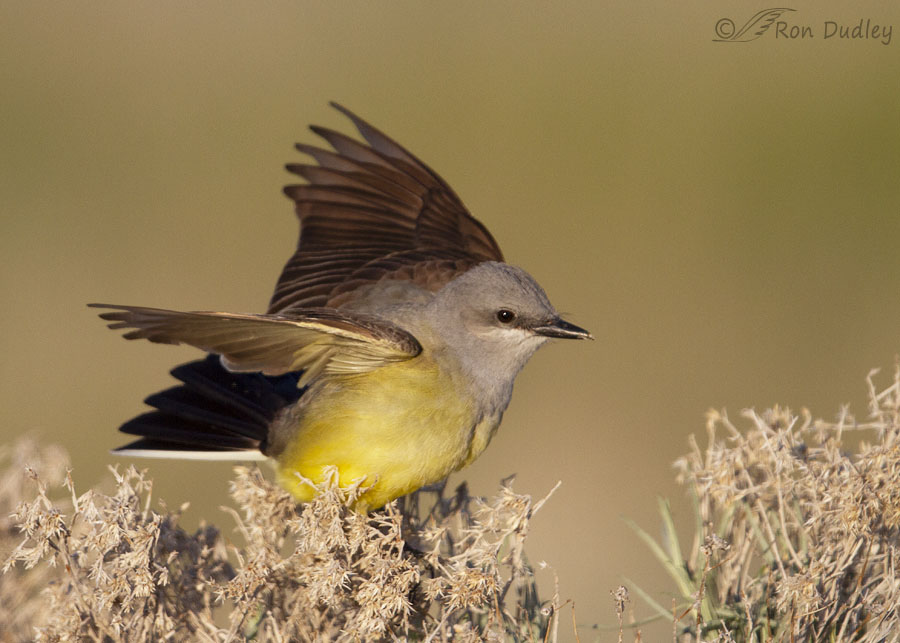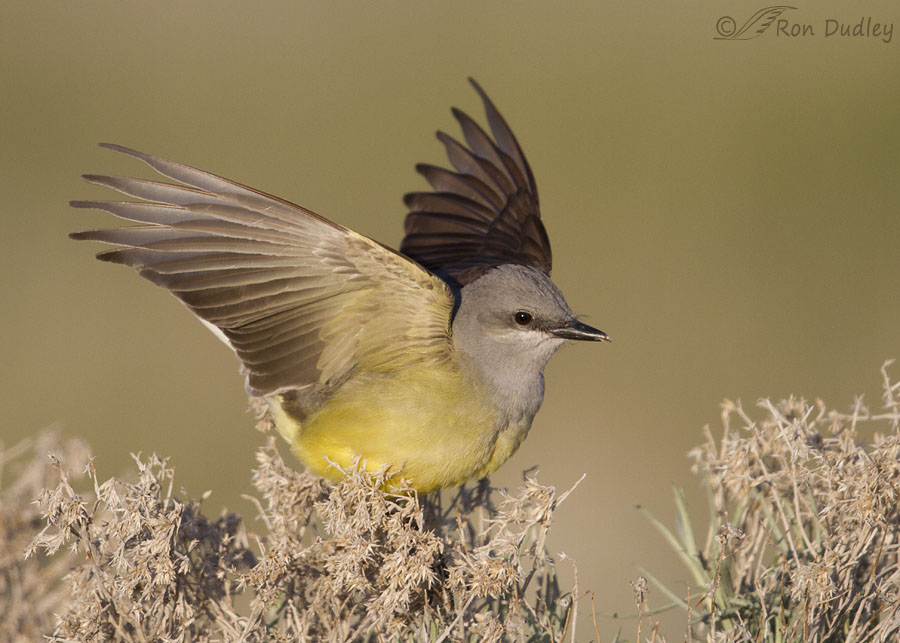Western Kingbirds are noted for their persistent belligerent behavior. This is one of nine different aggressive displays bird behaviorists have identified in the species.

1/3200, f/5.6, ISO 640, Canon 7D, Canon EF 500mm f/4L IS II USM + EF 1.4 III Extender, not baited, set up or called in
Western Kingbirds vigorously defend the territory around their nest against other birds and predators of various kinds (they’re called kingbirds for good reason). This is the male of a pair that was building their nest on Antelope Island several years ago. In this species only females actually build the nest. The contribution of the male is to guard her and their territory during the nest-building process and this guy was taking his job seriously. While she was delivering nesting material he would either be stationed on a prominent perch as he watched over her or making patrol flights so he could chase off any invaders when necessary.
One of the nine identified belligerent behaviors is called the Wing Flutter where the kingbird partially extends his wings and then flutters them in small arcs. This behavior suggests an aggressive state, often directed toward other kingbirds, but fights don’t usually follow. He did it most often immediately after landing on one of his favorite perches very near the nest which is what he’s doing here.

1/3200, f/5.6, ISO 640, Canon 7D, Canon EF 500mm f/4L IS II USM + EF 1.4 III Extender, not baited, set up or called in
In the next frame in the burst he had twisted his flared tail to his left and upward where it was hidden by his right wing.
The display usually didn’t last very long and he usually performed it immediately after landing so it was difficult to photograph. But he was fairly predictable for landing on this particular perch (and performing the display immediately after) which made it a little easier so eventually I succeeded several times.
Persistence pays off. Sometimes.
Ron
Notes:
- Despite the aggressive nest defense of Western Kingbirds predation is still a major cause of egg and nestling mortality. This nest eventually failed. I don’t know why it failed but predators could very easily have played a role.
- I find it interesting that this male regularly chased off other birds and I’m confident he’d have reacted similarly to any other mammalian or reptilian predator that approached his territory but he almost completely ignored me. Perhaps he recognized that people in vehicles usually don’t present a threat (in several sessions with these birds I never got out of my pickup anywhere near the nest.)


Beautiful shots Ron!
Charlotte
Thanks, Charlotte.
Our King Parrots are very, very low in the pecking order and are frequently routed by smaller birds. They are truly agressive to other King Parrots though. Have you noticed that the smaller birds are often the most bolshy? It is certainly true here.
Thank you, as always, for the beautifully illustrated lesson to start my morning.
“Have you noticed that the smaller birds are often the most bolshy?”
I certainly have, EC. I suspect it’s largely because smaller birds are faster and more maneuverable so they can (usually) get away with it without paying a deadly price.
I had to look “bolshy” up. Thanks for the continuing education…
Ron, both are great shots. I like the 2nd one in particular because the beautiful underwing is displayed. Your narrative is quite interesting, as usual. Thank you, Ron
Thanks, Alice. I tried to anticipate which of the two most folks would like better (when I was choosing my Featured Image for Facebook). One has a better look at his wings but his tail is hidden. Looks like most readers prefer the same one you do (I chose the other one for FB…).
Beautiful shots. I love all the information you extend about behavior and species differences. A lot of birds you include I have never seen but like learning about them. Great nature series.
I appreciate that, Betty Thank you.
Great shots Ron. What is the name of the plant the male is on?
Many thanks for sharing.
Dick, they’re the dried flowers of the previous year’s rabbitbrush.
I love how the coloration of the bird is picked up in the background. 🙂
Thanks, Arwen.
Very interesting Ron, and excellent photos. I have taken many photos of both Cassin’s and Western Kingbirds here in the Prescott area, but I don’t think I have ever come upon them during nesting season. Or possibly I have and failed to recognize any aggressive behavior. Cornell says predation accounts for the majority of nesting failures and predators include snakes, squirrels, woodrats, owls, hawks, falcons, ravens, crows, Magpies, and Shrikes. Obviously a tough 24/7 job to successfully defend their nests.
Thanks, Everett. I think it’s very interesting how aggressive behavior has been selected for so strongly in this and related species. I wonder if it’s somehow related to some vulnerability of their nesting habits or nest locations.
Beautiful shots, Ron……. 🙂 They can be aggressive particularly with dog/cats/other birds! Power lines here are a favorite perch. That being said I haven’t seen any this year and there were few last year. Few Eastern’s this year also but then it’s been a weird year for everything. Ours have always been paler in color than this one though, perhaps, it’s because I’ve seen them in summer rather than spring.
I’ve seen fewer of them this year than usual too, Judy. Haven’t even taken any decent shots of them. They’e one of my favorite species for behavior photography, in part because they’re so aggressive.
Oh my…that second photo is just beautiful! (not excluding the first in that statement). Seeing those feathers displayed like that on the wing underside…simply beautiful. Also the translucent appearance of the right wing feathers caught my eye immediately! 😍 I did not know these facts about their behavior. I’m thinking our Eastern Kingbird (white in place of yellow) probably does likewise…I’ll have to read up on them. I’ve seen the wing flutterings but didn’t know why it was done. I came across a small flock last p.m. feeding and they kept landing on the tops of native sunflowers…of course the sun was low behind them so no photos!
Kathy, we have both species here but Western’s are far more common. Both species are very aggressive but some of the belligerent behaviors of Westerns are exclusive to them, especially those involving the often hidden red crown that the Eastern lacks. Westerns often flash their red crowns in some of their aggressive behaviors.